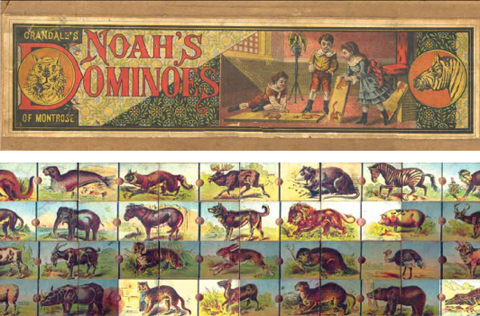By Anne Furnish Cartwright

The earliest reference we have to the game of dominoes dates back to Chinese writings of around 900 AD. The earliest set of dominoes known, also Chinese, dates from 1120 AD.
A set of Chinese dominoes (not to be confused with mahjong), is composed of 32 tiles representing various (but not all) combinations of throwing a pair of dice and includes some duplicates. Western sets have only 28 tiles: every possible result for throwing a pair of dice plus an additional seven blank tiles. The Chinese tiles are longer and narrower than Western tiles and are played like cards whereas, the “double square” tiles used in Western games all involve the formation of chains of tiles. These flat domino tiles may have evolved from early dice (cubes) and were made of bone with black spots (pips) with the two ends of the tile representing a pair of dice.
Dominoes first appeared in Italy in the early 1700s. They quickly became popular and by the end of the 18th century spread to France and Britain, and eventually to the rest of Europe and America.
The name “domino” is thought to derive from the French word for the hooded cloak worn by a priest in winter, or possibly from the hooded cloak worn with a mask to a masquerade ball (black with a white lining or the holes in the mask representing spots): early dominoes had black spots on white bone or ivory, later dominoes had white spots on black wood.
There are many different games that can be played with dominoes. There are also many different types of sets involving more then the usual 28 tiles and/or more than six spots as the highest number, and the more tiles, the more players. Whatever the origin of the name, the dominoes I collect are not all black and white. I collect those with pictures. These are games based on the arrangements of the tiles used in playing the game of dominoes.
